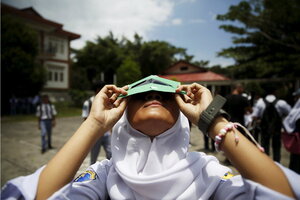Tuesday's total solar eclipse: How, when, where, to watch
During a solar eclipse, when the moon throws the Earth into shadow, it will block out the sun's light for anywhere between 90 seconds to 4 minutes.

A student looks at the sun through a self-made filter after a joint workshop between the Hong Kong Astronomical Society and Indonesia's National Institute of Aeronautics and Space at a high school in Ternate island, Indonesia, ahead of Wednesday's solar eclipse, March 7, 2016.
Beawiharta/Reuters
It's the first – and only – total solar eclipse of 2016: On March 8 and 9, the moon will pass in front of the sun, forming a rare celestial spectacle for parts of southeast Asia and surrounding areas.
Viewers across Indonesia, including the islands of Sumatra, Borneo, Sulawesi and Halmahera, will experience the full total solar eclipse. A partial eclipse will be visible over southern and eastern Asia, northern and western Australia, and parts of Hawaii and Alaska.
Mainland US will miss out on the show this year, but fear not: stargazers across the world can watch the eclipse live in a webcast hosted by the Slooh Community Observatory, broadcast from Indonesia, from 6 p.m. EST to 9 p.m. EST or on NASA TV, starting at 8 p.m. EST.
The eclipse offers a traveling show of sorts: It begins in the skies over Indonesia, then travels almost 9,000 miles northeast to Borneo, Papua New Guinea, and the Pacific Ocean over the course of three hours. At its widest, the eclipse's shadow will measure 97 miles across. In any given location, it will block out the sun's light for anywhere between 90 seconds to 4 minutes.
Solar eclipses are the stuff of celestial happenstance: They occur when the moon passes between the Earth and sun, blocking out the sun in an astronomical illusion that makes it appear as though the sun has disappeared. Tuesday's solar eclipse is special for two reasons: It's a total solar eclipse, which means the sun's disc will be completely covered, exposing the faint halo of rays known as the corona. And it's occurring during perigee, the moment when the moon is at its closest point to Earth. That will make the moon look especially large to Earthly viewers.
The eclipse will offer NASA scientists a rare chance to study the Sun's corona, which can emit intense blasts of charged particles that interfere with electronics on Earth. Because the corona is a million times fainter than the sun, it is typically difficult to see and study, especially against the bright light of the sun.
"It's like looking at this very dim light with a very bright light right next to it," Alex Young, a solar scientist at NASA’s Goddard Space Flight Center, told The Verge.
Tuesday's eclipse will block out the sun's intense light, allowing researchers to study the fainter corona. "We can make artificial eclipses on the ground and in space, but nature does it so much better than we can do."
While there are a number of unsubstantiated old wives tales about the effects of eclipses on humans, research has shown solar eclipses do have an measurable effect on plants and animals.
During past eclipses, ants have returned to their nests, grasshoppers have stopped chirping, and birds have stopped singing, for example. That's because the momentary darkness that solar eclipses bring trick plants and animals into thinking it's nighttime.
“It might only be three minutes of totality [in each location along the path],” Slooh founder Michael Paolucci told Wired, “but the entire environment reacts immediately – you’ll see cows hustling back to the barn thinking they’re late, birds fluttering. It’s a cool moment.”
The flight of insects who use light for navigation – like butterflies and moths – may also be affected.
“It is possible some animals may find their routine disrupted and become confused or anxious,” an RSPCA spokesman warned the UK's Telegraph.
And when the eclipse is over and light once again overtakes the darkness, the Sun's re-appearance "can trigger a false dawn chorus," reports the Telegraph, with cocks crowing, frogs croaking, and birds chirping.
As always, eclipse-watchers are advised not to look directly at the sun during the eclipse. Instead, NASA recommends using solar-filtered telescopes, eclipse glasses, or pinhole projectors.
However you view it – on the ground, via webcast, or NASA TV – don't miss the celestial event of the year. The next total solar eclipse won't occur until Aug. 21, 2017.

